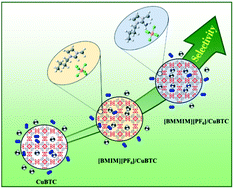Effect of methylation of ionic liquids on the gas separation performance of ionic liquid/metal–organic framework composites†
Abstract
1-N-Butyl-3-methylimidazolium hexafluorophosphate, [BMIM][PF6], and its methylated form, 1-N-butyl-2,3-dimethylimidazolium hexafluorophosphate, [BMMIM][PF6], were incorporated into CuBTC to examine the effect of methylation of ionic liquids (ILs) on the gas separation performance of the corresponding IL/metal–organic framework (MOF) composites. Spectroscopic analysis revealed that the interactions of the methylated ILs with CuBTC were weaker compared to those of its non-methylated counterpart. Gas uptake measurements illustrated that this difference in the interactions influences the gas separation performance of the composites. Accordingly, the CO2/N2: 15/85 and CH4/N2: 50/50 selectivities increased by 37% and 60% for [BMMIM][PF6]/CuBTC and 34% and 50% for [BMIM][PF6]/CuBTC, respectively, compared to the corresponding selectivities of pristine CuBTC at 1000 mbar. The results revealed another structural parameter controlling the performance of the IL/MOF composites, a novel type of material with rapidly expanding application areas.



 Please wait while we load your content...
Please wait while we load your content...